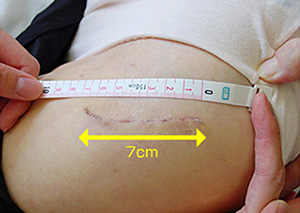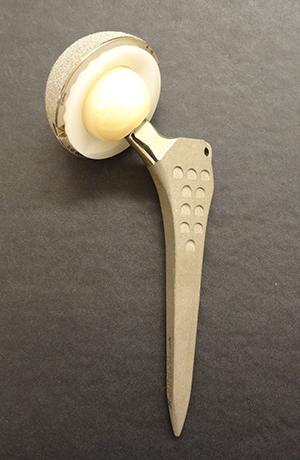 |

Traditional hip replacement surgery involves making a 15-20cm incision (Picture 1). On the other hand, MIS lets the surgeon perform hip replacement through a 7 cm incision (Picture 2). MIS causes less damage to muscles and skin and the hospital stay can be shorter.
MIS has started to be performed in Japan recently. Since this procedure is very difficult and is not suitable for all patients, there are very few hospitals where MIS is performed. We recommend that you receive advice and surgery from a doctor who has mastered the MIS procedure. MIS enables some patients to go home on the day of the surgery in the US. We offer hospital stay plans as short as 4 days. You can decide the length of your hospital stay depending on your schedule.
 Picture1
Picture1 Picture2
Picture2

|
Total hip replacement surgery has been performed all over the world since 1960’s. The destruction of hip joint caused by osteoarthritis of the hip, osteonecrosis of the femoral head, rheumatoid arthritis etc. lead to hip replacement. About 500,000 hip replacement surgeries are performed annually in the world. The implant has two parts, femur part and pelvis part. They are made of cobalt-chromium or titanium. The pelvic part usually has a polyethylene cup surrounded by a metal shell. The implant is either fixed with bone cement or without cement. We use cementless procedure to adhere the implant to the bone directly.

Hip replacement surgery requires blood transfusion. To replace lost blood during surgery, we ask the patients to save up their own blood before surgery, so that we can avoid blood transfusions from other people. In short the patients donate their blood beforehand for themselves.

We have prepared detailed pamphlets for patients who will have hip replacement surgery. You can read about disease, surgical procedures, and what to be careful of in the hospital and at home. We give it to patients who will have the surgery and who want to know more about it while considering the operation. |
 Picture3: Implants
Picture3: Implants |

The symptoms will be dramatically reduced after the hip replacement surgery. However, there are some possible risks associated with the surgery. We believe that we are responsible for reducing such risks.
- ● Bone Fracture during surgery (5%)
- The fracture of pelvis or femur occurs on rare occasions and in that case we will fix it using wire or metal plates.
- ● Dislocation (2-3%)
- After the surgery if you assume an improper position with your legs, dislocation of the artificial femur head may occur. When the dislocation occurs, we will fix it under anesthesia. Generally no second surgery is needed.
- ● Deep Venous Thrombosis (10-20%) and Pulmonary Embolism (0.5%)
- This is a phenomenon when blood clots (thrombosis) form in a vein of inferior limbs or in an artery in the lung. When the clots form, treatment with anticoagulant is needed.
- ● Infection (less than 1%)
- Infection may occur on rare occasions.
- ● Aseptic Loosening (5% in ten years after surgery)
- Aseptic loosening sometimes occurs between the metal and the bone many years after the surgery. In that case surgery to replace the implant (re-replacement surgery) will be needed.
- ● Wear of the Artificial Joint
- The artificial cartilage made of high-density polyethylene becomes worn by an average of 0.1mm per year. When the wear is severe, we replace the polyethylene by surgery.
- ● Osteolysis (5-30% in ten years after surgery)
- The fine grains of the worn polyethylene may weaken the hip joint bone.
- ● Nerve Injuries (1-4%)
- Nerve symptoms such as numbness of lower limbs or loss of muscle strength may occur after the surgery.
- ● Vascular Injuries (less than 0.3%)
- When we place the prosthesis, vascular injuries and bleeding may happen on rare occasions.
- ● Leg length Discrepancy (less than 50%)
- During placement of the artificial joint, we lengthen the lower limb according to the preoperative evaluation. If the length of the affected side is shorter and results in any unevenness, we try to make the length as even as possible. However, some patients may feel the difference between the legs after surgery.
- ● Swelling and Bleeding (approximately 100%)
- Postoperative swelling and subcutaneous internal bleeding disappear gradually.
- ● Thigh Pain (5-10%)
- There may be rare occasions of listlessness, unpleasant sensations, or dull pains in the thigh.
- ● Heterotopic Ossification (1-53%)
- This is a phenomenon when new bone forms around the hip joint.
 |
 |
|
 |